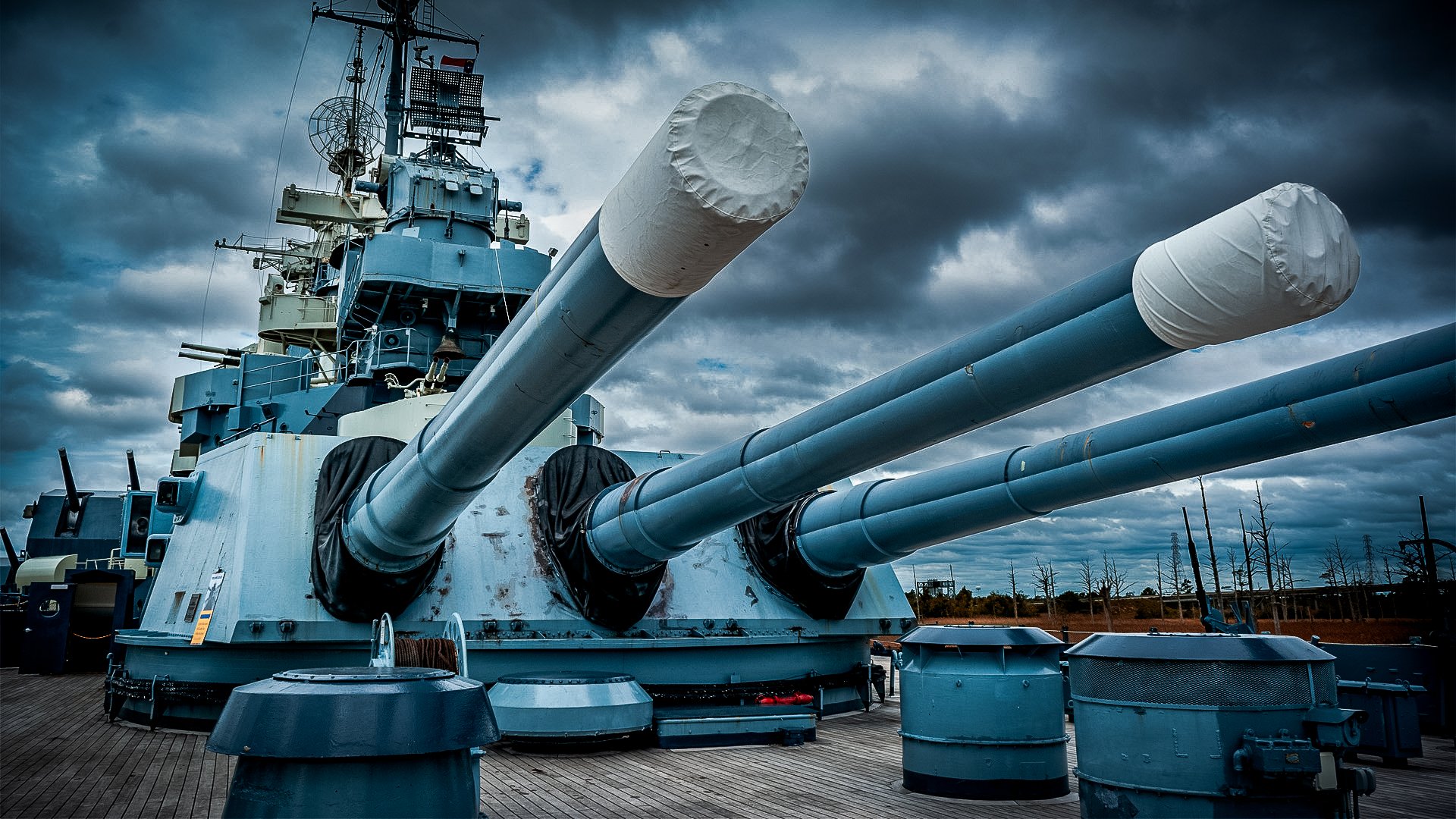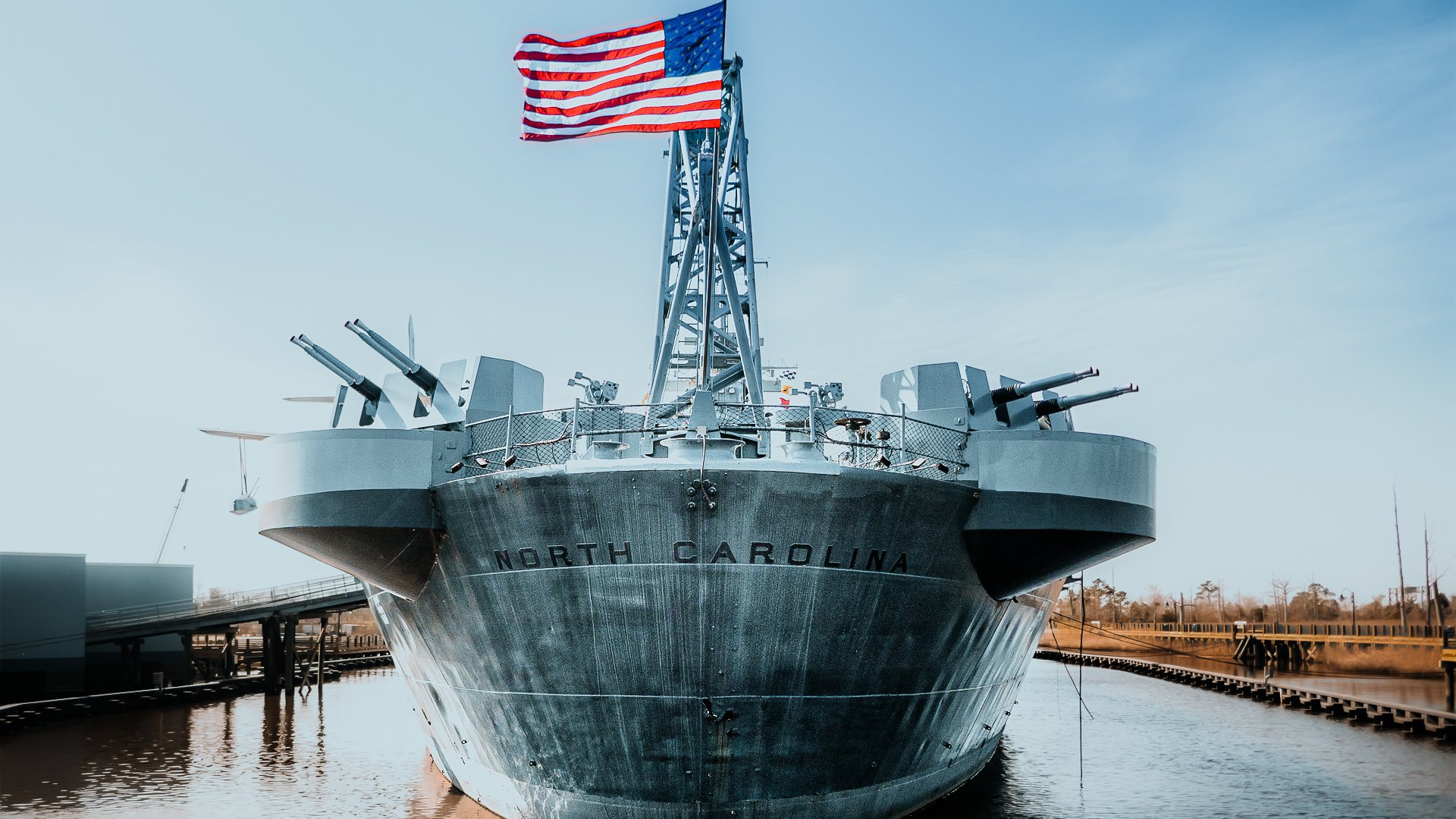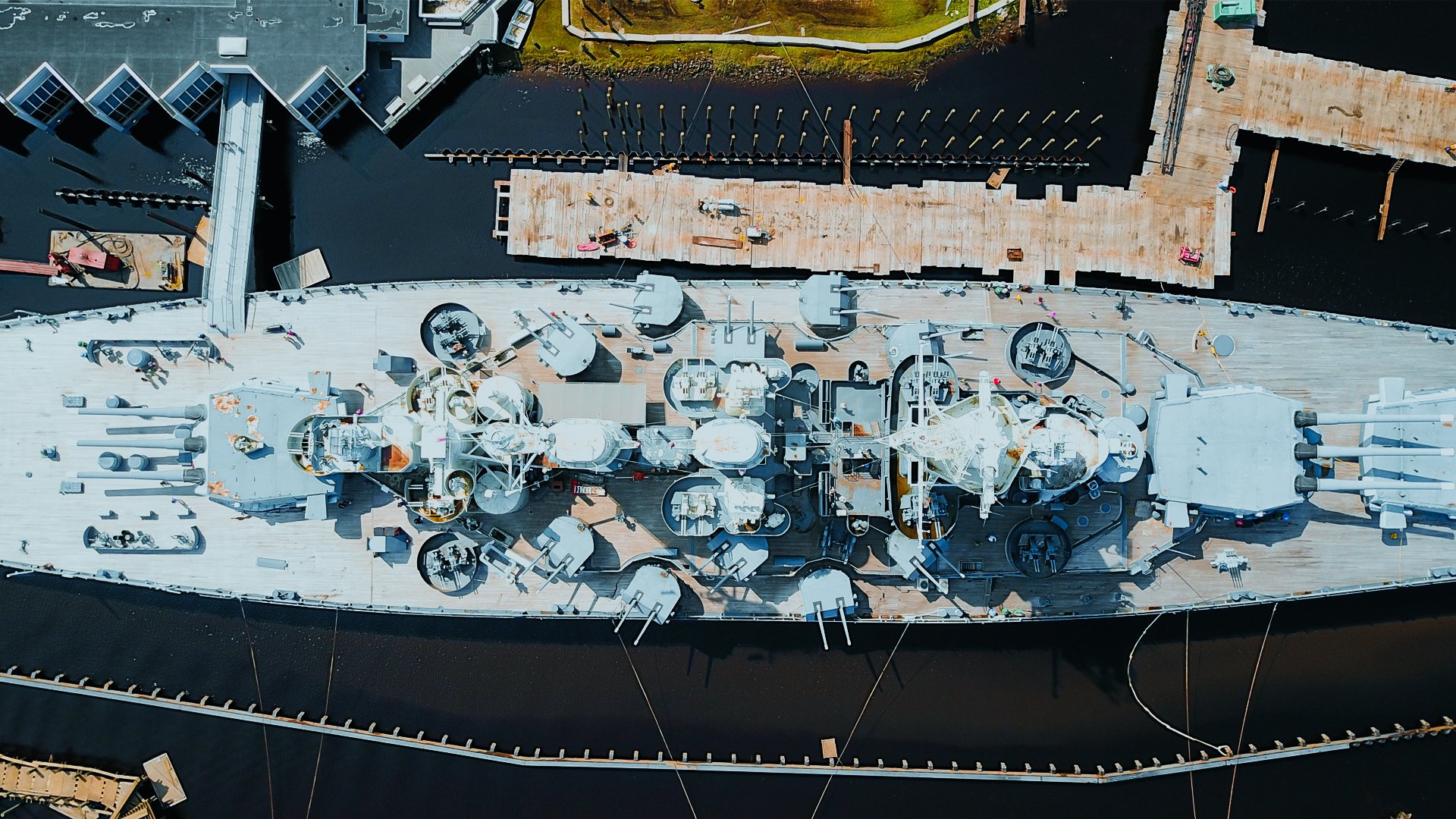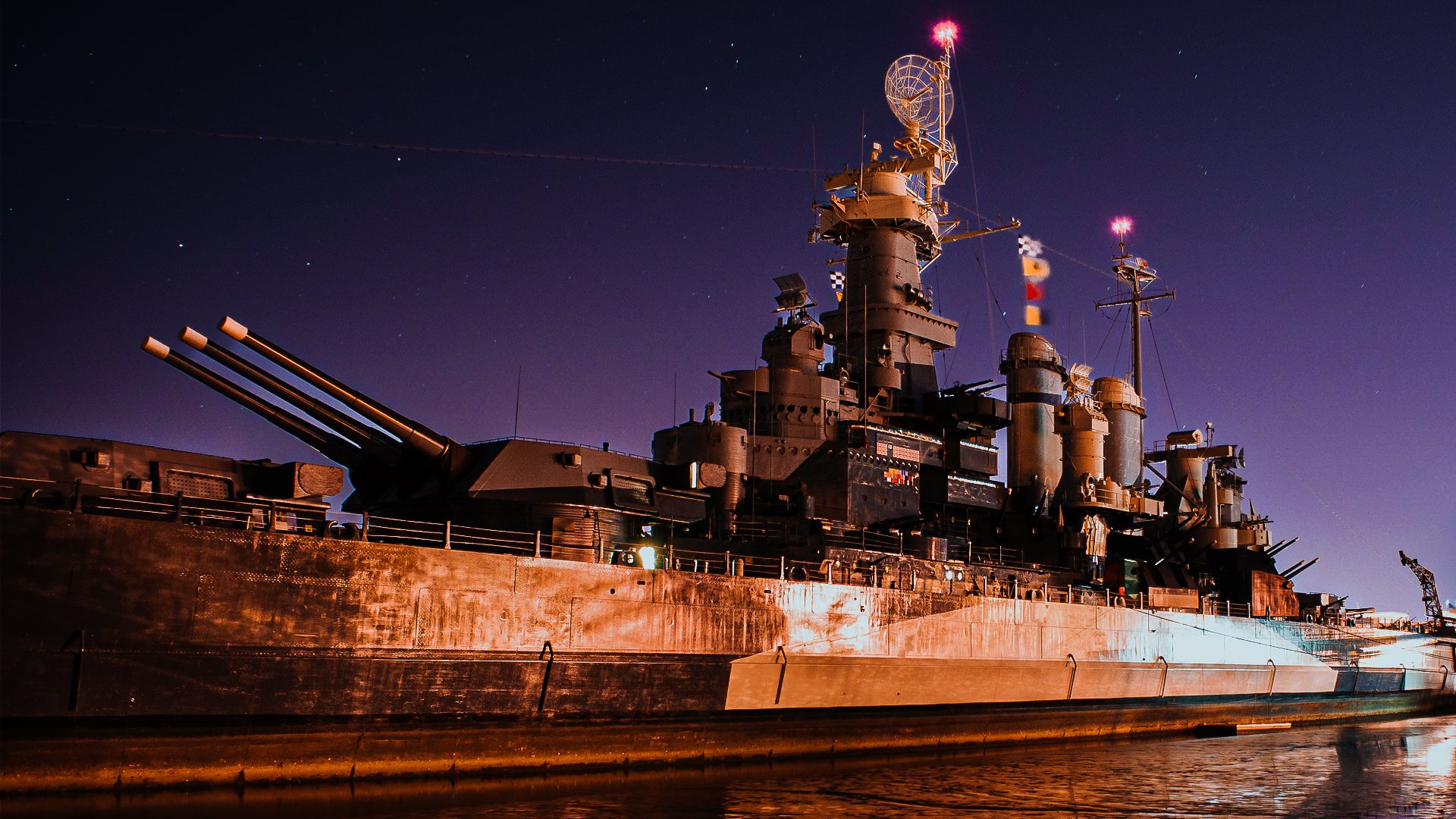
USS North Carolina (BB-55) anchored in Wilmington, North Carolina. Adobe Stock photo.
The USS North Carolina made news in July 2021 when the cofferdam surrounding the storied warship was intentionally flooded, returning the 728-foot vessel to the brine of the Cape Fear River after a three-year, $11 million facelift.
Since 1961, the North Carolina has been anchored in Wilmington, North Carolina, where it serves as a floating museum and memorial for the 11,000 North Carolinians who died in World War II. To this day, it remains one of the state’s biggest tourist destinations.

View of the USS North Carolina from shore looking directly at the stern. Adobe Stock photo by Gerald Zaffuts.
Commissioned in April 1941, the North Carolina (BB-55) was the United States Navy’s first “fast battleship.” With a top speed of 28 knots, the North Carolina was significantly faster than the World War I-era dreadnoughts that it replaced. Not only was the ship fast enough to escort aircraft carriers, it also packed enough firepower to hold its own in sustained combat. In addition to its 1,800-man crew, it carried 45 anti-aircraft weapons and 18 .50-caliber machine guns. Those, combined with a pair of aircraft catapults and a heavily armored conning tower, made the North Carolina an incredibly formidable ship.
Like most heroes of the Pacific, the North Carolina saw a great deal of action during the war. Though it was operational for only six years, it earned a record 15 battle stars and the distinction of being the most-decorated battleship of World War II.
Related: The M4 Sherman Tank: The Tank That Won WWII
The North Carolina Goes to War
The North Carolina was undertaking its shakedown cruise in the Caribbean when the Japanese attacked Pearl Harbor. After the US officially entered World War II, the North Carolina accompanied the initial wave of American forces into the fight. It passed through the Panama Canal on June 10, 1942, and escorted aircraft carriers across the world to the island of Guadalcanal for the first offensive campaign in the South Pacific.

USS North Carolina (BB-55) pitching in heavy seas while screening Task Force 38.3 off the Philippines, December 1944. Photo courtesy of Wikimedia Commons.
In August 1942, during the Battle of the Eastern Solomons, the North Carolina shot down as many as 14 enemy planes, while the Japanese managed to kill just one of its crew members. Less than two weeks later, five more sailors from the North Carolina were killed when a Japanese submarine struck the ship with a torpedo. Flooding from the blast caused a portside list, but the crew counter-flooded the starboard side, enabling the ship to return to Pearl Harbor for repairs.
By November, the North Carolina was back off the coast of Guadalcanal, where it would continue supporting ground forces with Task Force 64 for the remainder of the bloody six-month campaign. Following the Allied victory in Guadalcanal, the ship embarked for Pearl Harbor. There, both its radar and fire control equipment were upgraded in preparation for the next phase of fighting in the Pacific.
Related: ‘The Mighty A’ — Reliving History Aboard the USS Alabama
Island-Hopping
Eight months after leaving Guadalcanal, the North Carolina returned to the South Pacific. In November 1943, it conducted pre-invasion bombardments for the amphibious assaults on the Gilbert and Marshall Island chains.

USS North Carolina was the most advanced battleship of its day. Adobe stock photo.
On February 17, 1944, the North Carolina participated in Operation Hailstone, a campaign to destroy a massive Japanese base in Truk Atoll (now known as Chuuk Lagoon). The North Carolina helped sink 47 Japanese ships during the battle, which would go down as one of the biggest naval victories of the entire war. From there, the ship sailed again for Pearl Harbor, where it received a new rudder.
On June 6, 1944, while Allied forces were fighting on the beaches of Normandy to begin the liberation of Europe, the North Carolina was on the other side of the world, shelling the island of Saipan. The ship destroyed several enemy vessels and supply depots to clear the way for an amphibious assault. US Marines landed on Saipan nine days later and fought for more than three weeks to take control of the island.

USS North Carolina in Pearl Harbor, Nov. 16, 1942. Photo courtesy of Wikimedia Commons.
Seizing Saipan broke a hole in Japan’s defensive perimeter. The Japanese fleet responded with a massive counterattack in the Philippine Sea. The North Carolina fired the opening salvo of the battle that ensued. By the time the smoke cleared, the Japanese had lost three aircraft carriers, between 550 and 650 aircraft, and nearly 3,000 sailors. Only one American ship, the USS South Dakota, was damaged.
While the Japanese navy licked its wounds, the North Carolina returned to the United States for a complete overhaul at the Puget Sound Navy Yard.
Related: Don’t Give Up The Ship: Why The Navy’s Mantra Really Belongs To The Marines
At Japan’s Doorstep
The North Carolina returned to the Pacific in November 1944. On February 19, 1945, it provided fire support for the invasion of Iwo Jima. The ship shelled Japanese positions on the island nonstop for four days.

The 728-foot deck of the USS North Carolina as seen from above. Adobe Stock photo.
From Iwo Jima, the North Carolina sailed for the Japanese home islands. On April 1, it participated in the assault on Okinawa. During the chaotic battle, the North Carolina managed to shoot down three kamikaze aircraft, but it lost three of its crew members to friendly fire.
The ship remained in the theater until April 17, when it returned to Pearl Harbor for its last round of repairs. The Japanese surrendered four months later.
Related: Portrait of a Ship: USS Abraham Lincoln
Lasting Legacy
Immediately after the war, the North Carolina was deployed to the Caribbean to serve as a training vessel for midshipmen from the US Naval Academy. Then, on June 27, 1947, the most-decorated battleship of World War II was decommissioned.

The USS North Carolina at night. Adobe Stock photo.
The North Carolina was nearly scrapped for parts in 1960, but it was saved from that inglorious fate by a successful grassroots campaign to transform the ship into a floating museum. Seven years after the ship anchored in Wilmington, a bridge was constructed across the Cape Fear River, effectively trapping it in.
Today, visitors can tour the legendary warship. On May 29, the North Carolina will host a free Memorial Day celebration, complete with a wreath-laying ceremony and 21-gun salute.
Read Next: Profile of a Ship: USS Carl Vinson

Mac Caltrider is a senior staff writer for Coffee or Die Magazine. He served in the US Marine Corps and is a former police officer. Caltrider earned his bachelor’s degree in history and now reads anything he can get his hands on. He is also the creator of Pipes & Pages, a site intended to increase readership among enlisted troops. Caltrider spends most of his time reading, writing, and waging a one-man war against premature hair loss.
BRCC and Bad Moon Print Press team up for an exclusive, limited-edition T-shirt design!
BRCC partners with Team Room Design for an exclusive T-shirt release!
Thirty Seconds Out has partnered with BRCC for an exclusive shirt design invoking the God of Winter.
Lucas O'Hara of Grizzly Forge has teamed up with BRCC for a badass, exclusive Shirt Club T-shirt design featuring his most popular knife and tiomahawk.
Coffee or Die sits down with one of the graphic designers behind Black Rifle Coffee's signature look and vibe.
Biden will award the Medal of Honor to a Vietnam War Army helicopter pilot who risked his life to save a reconnaissance team from almost certain death.
Ever wonder how much Jack Mandaville would f*ck sh*t up if he went back in time? The American Revolution didn't even see him coming.
A nearly 200-year-old West Point time capsule that at first appeared to yield little more than dust contains hidden treasure, the US Military Academy said.












